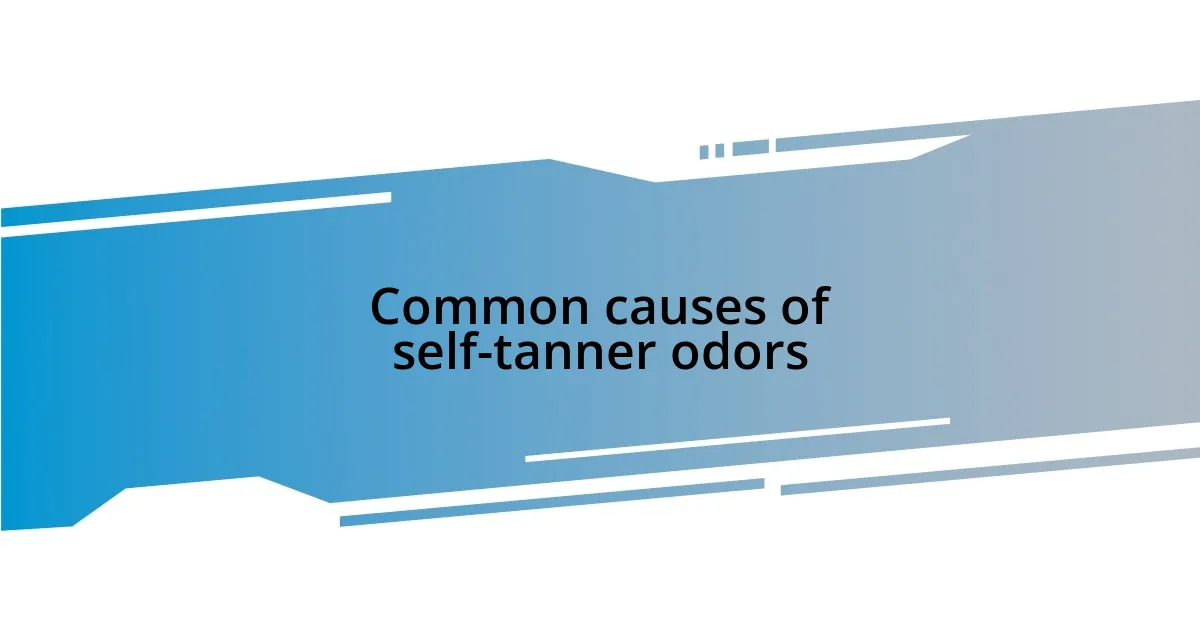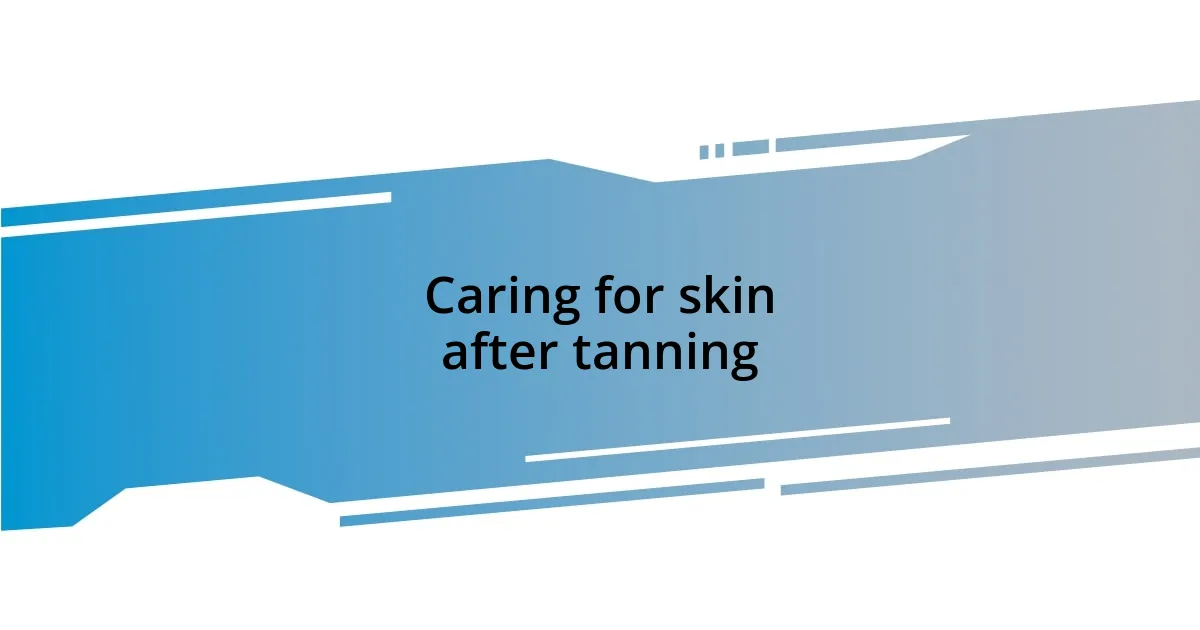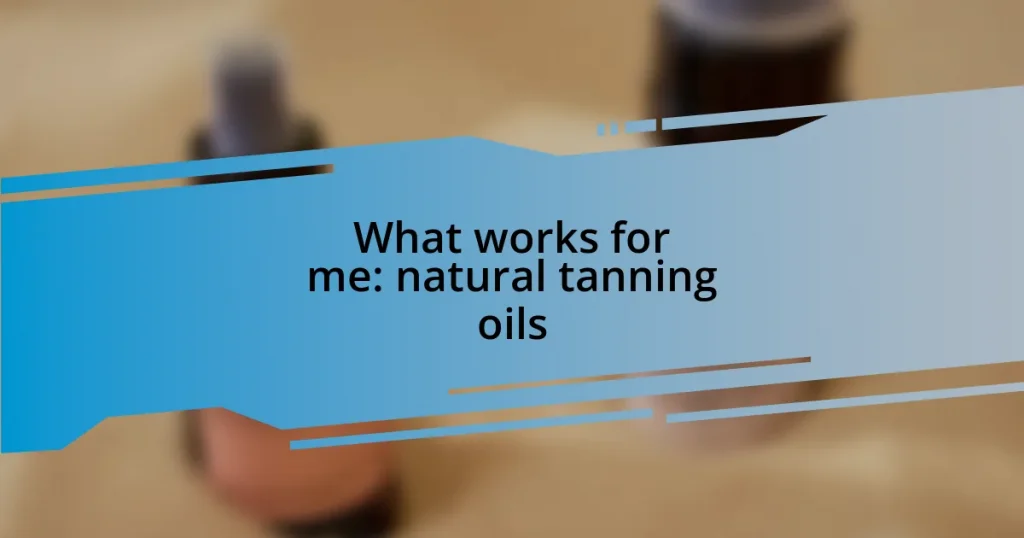Key takeaways:
- The main odor from self-tanners is due to dihydroxyacetone (DHA), which reacts with skin, while product ingredients and skin chemistry also affect the smell.
- Choosing low-odor self-tanners, especially those labeled “fragrance-free” or with natural scents, can lead to a more pleasant experience.
- Proper skin preparation, like exfoliation and moisturizing, is crucial to minimize odors and ensure an even tan.
- Using scent-masking techniques, such as applying scented oils or mixing perfume with self-tanner, can significantly enhance the tanning experience.

Understanding self-tanner smell
The smell associated with self-tanners primarily comes from dihydroxyacetone (DHA), which is the active ingredient responsible for that sun-kissed glow. I remember the first time I applied a self-tanner; I loved the color but was taken aback by the scent. It made me consider: why does something that aims to make us look radiant often carry such an off-putting odor?
Interestingly, the intensity of the smell can vary between products. Some brands add fragrances to mask the natural DHA scent, while others opt for a more straightforward approach. I’ve tried my fair share of self-tanners—some made me feel more confident, while others left me questioning my decisions due to their overpowering stench. Have you ever found yourself in a similar situation, torn between a beautiful tan and an unpleasant scent?
Another factor in the self-tanner aroma puzzle is skin chemistry. How our skin reacts to the product can change the smell, and this was a lightbulb moment for me. I once had a mishap with a product that seemed heavenly on the label but turned musty on my skin. It makes me wonder—how much do we really consider our unique skin type when choosing a self-tanner? Understanding this might just empower us to make better choices in our quest for that perfect glow.

Common causes of self-tanner odors
Self-tanner odors can be a real conundrum, and I’ve found that several elements contribute to that distinctive scent. At the heart of it all is dihydroxyacetone (DHA), which, when it reacts with the amino acids in our skin, can produce an odor that many of us would rather avoid. There have been times when I was out and about, feeling great about my glow, only to catch a whiff of something less than pleasant wafting from my arms.
The problem doesn’t stop at DHA alone. Other ingredients in the formulation can also play a role in how the scent evolves. Here are some common causes of self-tanner odors that I’ve identified:
- DHA reaction: The chemical reaction of DHA with skin creates the characteristic smell.
- Preservatives: Certain preservatives used in self-tanners can emit a strong scent.
- Alcohol content: Products with high alcohol levels can contribute to unpleasant odors upon application.
- Skin pH: The natural acidity or alkalinity of your skin can alter the scent of the tanning product.
- Ingredients: Fragrant oils or additives can interact with your skin chemistry, leading to unexpected smells.
I’ve learned that not every self-tanner is created equal. I remember a time I thought I found the holy grail of self-tanners, only to discover later that its lingering smell was a dealbreaker. The quest for that perfect tan may be complicated, but recognizing these common causes can help us choose wisely and potentially avoid the dreaded self-tanner stench.

Choosing low-odor self-tanners
Choosing a low-odor self-tanner can feel like searching for the holy grail, but it’s worth the effort. I recall a time when I stumbled upon a tanner that boasted a “fresh coconut” scent. The moment I applied it, I felt a wave of relief wash over me—no overpowering odor this time! It made me realize that when choosing low-odor options, looking for products labeled as “fragrance-free” or those with natural scent ingredients can make a significant difference.
Finding self-tanners with added botanical extracts or essential oils often leads to a pleasant aroma rather than the typical DHA scent. I once tried a tanner infused with aloe vera, which not only delivered a beautiful glow but also left my skin smelling light and refreshing. That was a game changer for me. Just remember to check reviews and ingredient lists before making your selection—community feedback can save you from unpleasant surprises.
Lastly, testing products on a small patch of skin is a tip I can’t stress enough. My experience taught me that even highly-rated tanners can be a gamble. One product that others praised left me feeling self-conscious due to its lingering smell. This precaution not only helps gauge your personal reaction but ensures that your chosen product aligns with your body chemistry. After all, who wants a lovely tan overshadowed by an unwanted scent?
| Self-Tanner Characteristics | Examples |
|---|---|
| Fragrance-Free | EcoTan, Loving Tan |
| Botanical Extracts | St. Tropez, Isle of Paradise |
| Tested on Skin | Vita Liberata, Tan-Luxe |

Prepping your skin effectively
Prepping your skin effectively can make all the difference when it comes to avoiding unwanted self-tanner smells. I’ve found that starting with clean, exfoliated skin is crucial. Imagine standing in the shower, feeling the warmth of the water, and as I scrub away dead skin cells, I can’t help but think about how this simple act can set the stage for a flawless tan. When your skin is free of dead layers, the self-tanner penetrates more evenly, reducing the potential for patchy areas that can amplify odors.
Moisturizing is another key step that I can’t overlook. I remember a time when I skimped on it, and the result was less than pleasant: a tan that appeared splotchy and carried that unmistakable self-tanner scent. Now, I apply a light layer of moisturizer to my elbows, knees, and any other dry spots. This ensures the tanner glides on smoothly and absorbs better, which helps to minimize the chemical interaction that leads to odors. Have you ever skipped this step and regretted it later? I know I have, and it taught me the value of a little extra care.
Finally, consider the timing of your application. One evening, I decided to apply self-tanner right before heading out. I was rushing, and I didn’t let it dry fully. The result? A quick whiff reminded me why I should never compromise on prep. Allowing your tanner proper time to set can significantly affect how it smells and looks on your skin. Trust me, taking these extra steps not only enhances your tan but also keeps that odor in check!

Applying self-tanner correctly
When applying self-tanner, the technique you use can change everything. I learned the hard way—that using too much product can lead to that dreaded sticky finish. I remember my first time applying it; I slathered the tanner on thinking more would give me a deeper color. Instead, it just left me feeling uncomfortable and smelling like the beach on a hot day—without the pleasant ocean breeze! Using just the right amount creates a smooth application and helps avoid any overpowering scents.
It’s also essential to use the right tools. I cannot emphasize enough how a good tanning mitt can be your best friend. The first time I tried applying self-tanner with my bare hands, I ended up in a frantic battle at the sink, scrubbing orange stains for hours. Switching to a mitt changed my experience entirely; there’s something satisfying about that even glide and the lack of mess. Plus, it prevents your hands from capturing and amplifying that classic self-tanner smell.
Don’t underestimate the importance of your environment during application. I prefer to set the mood, almost like a mini spa day. Play some soothing music and ensure proper ventilation. I remember deciding to do my self-tanner in a steamy bathroom once—bad idea. The heat made the product absorb differently, and the smell was more pronounced than usual. Now, I always make sure to apply it in a cool, airy space, transforming the process into something relaxing while also keeping any unpleasant odors at bay. Have you ever thought about how the environment impacts your beauty routine? It really does make a difference!

Using scent-masking techniques
Using scent-masking techniques can greatly enhance your self-tanning experience. Personally, I’ve discovered that applying a scented body oil or lotion right before using self-tanner can mask any unpleasant odors. I remember one evening getting ready for a special event; I layered on a coconut-scented oil, and as I applied the tanner, the delightful aroma filled the air. It turned a potentially awkward moment into a lovely, fragrant experience. Have you ever noticed how a pleasant scent can completely change the mood?
Another powerful technique is mixing a bit of your favorite perfume with the self-tanner itself. I learned this tip on a whim, and I’ve been hooked ever since. One day, feeling adventurous, I added a few drops of vanilla perfume to my self-tanner mix. The result was spectacular—a custom scent that lingered pleasantly as the tanner developed. I felt more confident and less self-conscious about the whole process. Isn’t it incredible how scent can uplift your spirits and alter your perception?
Lastly, I always keep a scented body spray nearby to refresh myself throughout the day as the tanner develops. There was a time when I didn’t do this, and I found myself feeling a bit self-aware about the smell. Now, a quick spritz of my favorite floral mist can make a world of difference. It’s almost like an armor; I step out feeling empowered, knowing I’ve taken control of the scent. What about you? How do you keep your confidence up during the tanning process?

Caring for skin after tanning
After the tanning session, how you treat your skin can significantly affect the longevity of that beautiful glow. I’ve realized that hydration is key. A couple of days after I self-tan, I make it a point to apply a rich, moisturizing lotion. One time, I tried skipping this step, thinking it might lighten the tan, and oh boy, my skin felt tight and patchy! That experience taught me to always treat my skin with kindness; a good moisturizer locks in that color and keeps my skin looking fresh.
Exfoliation is another essential part of my post-tanning routine, but timing is everything. I learned the hard way not to overdo it immediately after applying self-tanner. I once went in for an aggressive scrub two days post-tan and ended up with uneven patches. Now, I wait a good week before I start my exfoliation routine again. It’s all about maintaining an even glow and knowing when to take a break!
I also pay special attention to areas that tend to fade faster, like elbows and knees. I remember feeling frustrated with my tan wearing off unevenly, so I began using a lighter lotion on those spots to ease the intensity. It’s like having a mini touch-up without the mess of reapplying the tanner. Have you ever noticed how a little extra care can go a long way in showing off that sun-kissed look? Taking simple yet thoughtful steps makes a huge difference in the outcome.
















